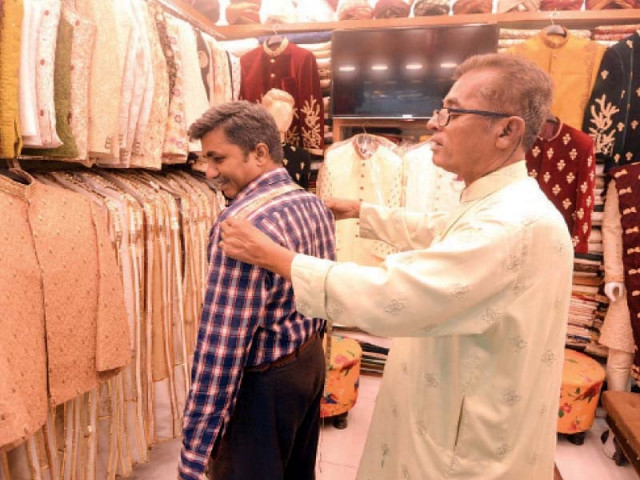Tailors charge premium as orders overflow
Raise stitching charges for kurta shalwar by 25 per cent

A rise of Rs300 in the wages of men's tailors has been witnessed before Eid this year. Subsequently, tailors have shifted the burden to the customers by raising the charges to stitch men's kurta shalwar from Rs1,200 to Rs1,500.
Those who work in dressmaking and stitching say that in addition to the wages of workers, the cost of materials and electricity has also skyrocketed. It has also resulted in people opting for ready-to-wear clothes instead of getting them stitched.
Leading up to and during Ramazan, there is a visible increase in demand for new clothes. It has been the same this year despite inflation and declining value of rupee impacting purchasing power.
Tailors remain busy and orders continue to pour in, with one tailor saying that he is likely to stop taking orders for delivery at Eid.
Seasonal tailors have also emerged, as is the norm during this period, who charge lower rates than permanent tailors. This is because their ability and stitching quality are inferior to those offered by permanent tailor shops, said one buyer. "Despite the increase in stitching costs, people still go to their permanent tailors," they said.
Early bird
The fabric for the Eid dress is often purchased and handed over to the tailor in the first week of Shaaban, the month preceding Ramazan in the Islamic calendar.
Some tailors accept orders from individual clients in Ramazan as well to deliver high-quality tailoring and charge whatever they want.
Eid orders can only be placed up to the fifteenth day of Ramazan in advance. In the first week of Ramazan, popular tailoring shops and men's tailoring centres in the city display new booking boards.
Changing patterns
While stitched and tailored have always been a sartorial preference, frequent power outages and increasing costs mean that there has been an increase in the demand for ready-to-wear dresses.
It has led to tailors establishing workshops and make-shift karkhanas in areas where power outages are comparatively less. A hefty amount of tailoring work takes place at night, when there are fewer power outages. In most cases, the business owner uses gas-powered generators are used in case of power outages.
Stylistic preferences
Clothing with embroidery carries a higher price than clothes without such adornments. Besides tailoring, embroidery, sewing machine repairing, scissors sharpeners, thread buttons, and other auxiliary materials are also associated with the job of tailors.
Younger buyers prefer minimal embroidery on their shirts and kurtas. The suits with embroidery on the front side in addition to the collar and sleeves have also found a niche.
However, embroidery carries an additional cost of Rs300 to Rs500 depending on the style. The cost of stitching for embroidered suits is also considerably higher than average. Cotton suits are more expensive to stitch than wash and wear clothing.
Workforce
Majority of seasonal workers in these shops are from outside the city. They often stay at the shop and stitch day and night. Most of these people are daily wage labourers.
The average daily income of workers this year is about Rs2,000. Workers in small tailor shops might earn up to Rs1,500 per day.
Stitching hubs
Major menswear tailoring centres in Karachi are Kareem Centre and Cooperative Market in Saddar where orders are taken until the third Ashra (last ten days of Ramazan). The charges of stitching also increase as Eid gets closer.
Tailors work till late on the eve of Eid (chand raat) and stitch clothes for themselves and their families. Shops tend to remain open the whole night once Eid moon has been sighted so that clothes can be delivered before the Eid prayer in the morning.
After that, it is a week of well-deserved rest for the stitching community. But they are back at it soon after as weddings tend to continue for the next couple of months till Zil Hajj.
Published in The Express Tribune, March 31st, 2023.



















COMMENTS
Comments are moderated and generally will be posted if they are on-topic and not abusive.
For more information, please see our Comments FAQ